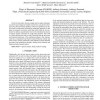Free Online Productivity Tools
i2Speak
i2Symbol
i2OCR
iTex2Img
iWeb2Print
iWeb2Shot
i2Type
iPdf2Split
iPdf2Merge
i2Bopomofo
i2Arabic
i2Style
i2Image
i2PDF
iLatex2Rtf
Sci2ools
ICASSP
2009
IEEE
2009
IEEE
Joint estimation of short-term and long-term predictors in speech coders
In low bit-rate coders, the near-sample and far-sample redundancies of the speech signal are usually removed by a cascade of a shortterm and a long-term linear predictor. These two predictors are usually found in a sequential and therefore suboptimal approach. In this paper we propose an analysis model that jointly finds the two predictors by adding a regularization term in the minimization process to impose sparsity constraints on a high order predictor. The result is a linear predictor that can be easily factorized into the short-term and long-term predictors. This estimation method is then incorporated into an Algebraic Code Excited Linear Prediction scheme and shows to have a better performance than traditional cascade methods and other joint optimization methods, offering lower distortion and higher perceptual speech quality.
Algebraic Code Excited Linear Prediction | ICASSP 2009 | Linear Predictor | Long-term Linear Predictor | Signal Processing |
| Added | 17 Aug 2010 |
| Updated | 17 Aug 2010 |
| Type | Conference |
| Year | 2009 |
| Where | ICASSP |
| Authors | Daniele Giacobello, Mads Græsbøll Christensen, Joachim Dahl, Søren Holdt Jensen, Marc Moonen |
Comments (0)

